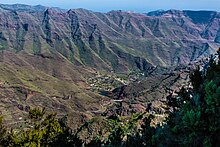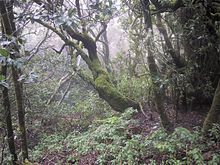 Satellite view of La Gomera | |
 | |
| Geography | |
|---|---|
| Location | Atlantic Ocean |
| Coordinates | 28°06′54″N 17°13′30″W / 28.11500°N 17.22500°W |
| Archipelago | Canary Islands |
| Area | 370.03 km2 (142.87 sq mi)[1] |
| Coastline | 100 km (60 mi)[1] |
| Highest elevation | 1,487 m (4879 ft)[1] |
| Highest point | Garajonay |
| Administration | |
Spain | |
| Autonomous Community | Canary Islands |
| Province | Santa Cruz de Tenerife |
| Capital and largest city | San Sebastián de la Gomera (pop. 9,584, in 2023) |
| Demographics | |
| Demonym | gomero/-a |
| Population | 22,361 (start of 2023)[2][3] |
| Pop. density | 60.43/km2 (156.51/sq mi) |
| Languages | Spanish (specifically Canarian Spanish) and Silbo Gomero |
| Ethnic groups | Spanish, Canary Islanders, other minority groups |
| Additional information | |
| Time zone | |
| • Summer (DST) | |





La Gomera (Spanish: [la ɣoˈmeɾa] ) is one of Spain's Canary Islands, in the Atlantic Ocean off the coast of Africa. With an area of 370.03 km2 (142.87 sq mi), it is the third-smallest of the archipelago's eight main islands. It belongs to the province of Santa Cruz de Tenerife. La Gomera is the third least populous of the eight main Canary Islands, with 22,361 inhabitants at the start of 2023.[4][3] Its capital is San Sebastián de La Gomera, where the cabildo insular (island council) is located.
- ^ a b c "Estadística del Territorio" [Territory Statistics] (in Spanish). Instituto Canario de Estadística (ISTAC). Retrieved 14 August 2019.
- ^ Instituto Nacional de Estadistica, Madrid, 2023.
- ^ a b "Real Decreto 1458/2018, de 14 de diciembre, por el que se declaran oficiales las cifras de población resultantes de la revisión del Padrón municipal referidas al 1 de enero de 2018" [Royal Decree 1458/2018, of 14 December, by which the population values resulting from the review of the municipal register of 1 January 2018 are declared official] (PDF). BOE (in Spanish). 29 December 2018. Retrieved 14 August 2019.
- ^ Instituto Nacional de Estadistica, Madrid, 2023.